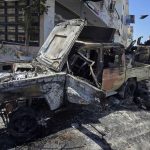Introduction
The conflict between Israel and Hamas, which escalated dramatically following the October 7, 2023 attacks by Hamas, has entered a critical phase in 2025. A recent hostage exchange, ceasefire, and renewed diplomatic efforts have brought a fragile pause, but the humanitarian situation in Gaza has reached catastrophe levels. This article explores the latest developments, global reactions, and the severe crisis unfolding in Gaza.
Recent Developments & Hostage/Prisoner Exchange
- On October 13, 2025, Hamas released the final 20 living Israeli hostages held since October 7, 2023, transferring them via the Red Cross.
- In exchange, Israel began releasing nearly 2,000 Palestinian prisoners, including about 1,700 detained since the war began and 250 with long sentences.
- The deal is part of a U.S.-drafted 20‑point peace plan that includes steps toward a ceasefire and partial military withdrawal.
- With the exchange underway, Hamas also deployed fighters in Gaza in a show of strength.
- Tens of thousands of displaced Palestinians have begun returning to northern Gaza under the ceasefire.
These developments reflect a moment of diplomatic opening, though with many unresolved and volatile elements remaining.
Also Read:Cloudburst in Dehradun: What It Reveals About Rising Climate Risks
Humanitarian Crisis in Gaza: Magnitude & Conditions
Famine, Malnutrition, and Starvation
- Gaza is now officially facing famine, particularly in Gaza City and adjacent areas, after nearly 22 months of conflict.
- According to the United Nations and associated agencies, nearly one in three people in Gaza go days without food.
- In recent screenings by medical organizations, 25% of young children and breastfeeding or pregnant women were found malnourished.
- Some hospitals have recorded malnutrition-related deaths, including among infants.
Infrastructure & Displacement
- According to satellite and humanitarian data, over 100,000 buildings have been destroyed across Gaza.
- Large tracts of neighborhoods, agricultural lands, schools, and hospitals lie in ruin.
- The United Nations has warned that a possible Israeli plan to take over Gaza City could displace around 800,000 people, many already displaced previously.
- Over the course of the conflict, much of Gaza’s critical infrastructure—roads, hospitals, water systems—has been severely damaged or rendered non-functional.
Access to Aid & Blockade
- Humanitarian organizations have repeatedly complained that Israel’s control over crossings and restrictions on movement are obstructing the flow of food, water, fuel, and medicines.
- The United Nations has demanded that Israel respect its obligations to allow safe passage of aid.
- Some aid agencies have expressed worries that ongoing military operations will prevent distribution of relief in many areas.
Global Reactions & Diplomatic Pressures
Countries & International Bodies
- At the outset of the conflict, dozens of nations condemned the Hamas attack as terrorism, while others urged restraint from both sides.
- Several countries, including France in 2025, have announced plans to recognize Palestinian statehood.
- In the midst of the crisis, world leaders have called for ceasefires, greater humanitarian access, and respect for international law.
- South Africa has taken the issue to the International Court of Justice (ICJ), seeking legal measures against Israel for alleged violations of the Genocide Convention.
- UN agencies, including the Office for the Coordination of Humanitarian Affairs (OCHA), have repeatedly warned of mass suffering, displacement, and civilian casualties.
Challenges to Consensus
- Some countries refrain from explicitly condemning either side, urging diplomacy and de-escalation instead.
- The question of disarmament of Hamas is a central, thorny demand by Israel and its supporters—Hamas resists giving up arms while framing them as necessary for resistance.
- There is tension between those pushing for an immediate ceasefire and those insisting on strict conditions (e.g. full release of hostages, security guarantees).
Risks, Obstacles & The Road Ahead
- Fragility of the Ceasefire
The current pause in conflict may be unstable. Either side may resume hostilities if demands are unmet or talks stall. - Compliance & Monitoring
Ensuring independent observation, verification of prisoner release, and border control remains a complex challenge. - Reconstruction vs Governance
Rebuilding Gaza is not just physical — who governs, how security is ensured, and how services restart are massive hurdles. - Accountability & Legal Claims
Many human rights bodies are investigating allegations of war crimes, violations, and possible genocide. - Humanitarian Shock & Long-Term Effects
Generations may suffer from malnutrition, psychological trauma, loss of education, and displacement. - Regional Spillover
Neighboring states, militant groups, and global powers may be drawn in (through borders, support, or diplomatic pressure).
Conclusion
The latest developments—a tentative ceasefire, major hostage and prisoner releases—have raised cautious hopes of momentum toward de‑escalation. But Gaza is in the throes of an unprecedented humanitarian catastrophe, with famine, infrastructure collapse, and mass displacement overwhelming local capabilities. Global reaction is pressing, yet contested. Whether diplomatic channels can stabilize the region and begin rebuilding remains uncertain.
Also Read : Nitin Gadkari Major Warning After Operation Sindoor: ‘World War III Could Erupt Anytime










